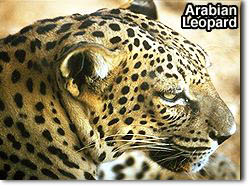Arabian Leopard
 Undoubtedly the most famous mammal of today is the Arabian leopard (Panthera pardus nimr ). The reason for its present fame is sadly, that it is on the brink of extinction. A spate of killings by hunters in the early 1990s triggered a conservation effort, spearheaded by the Arabian Leopard Trust, which aims at preserving the mountain habitat with all its wildlife. At about 30 kgs for the male and around 20 kgs for the female, the Arabian leopard is much smaller than most of the African and Asian races. Very light in colour, the deep golden yellow between the black rosettes is only present on the animal's back, whilst the rest of the body is beige to greyish-white. Leopards are not animals of the open desert and only occur in the mountains, where permanent water sources exist. In this arid terrain they require large territories in order to find enough food, which means that even at the best of times there have never been many leopards in this area. As they are solitary animals, the territory is fiercely defended against intruders. Whilst the area of a male might overlap with the territories of several females, no other animal of the same sex is allowed near what the leopard considers to be the core of its range. Undoubtedly the most famous mammal of today is the Arabian leopard (Panthera pardus nimr ). The reason for its present fame is sadly, that it is on the brink of extinction. A spate of killings by hunters in the early 1990s triggered a conservation effort, spearheaded by the Arabian Leopard Trust, which aims at preserving the mountain habitat with all its wildlife. At about 30 kgs for the male and around 20 kgs for the female, the Arabian leopard is much smaller than most of the African and Asian races. Very light in colour, the deep golden yellow between the black rosettes is only present on the animal's back, whilst the rest of the body is beige to greyish-white. Leopards are not animals of the open desert and only occur in the mountains, where permanent water sources exist. In this arid terrain they require large territories in order to find enough food, which means that even at the best of times there have never been many leopards in this area. As they are solitary animals, the territory is fiercely defended against intruders. Whilst the area of a male might overlap with the territories of several females, no other animal of the same sex is allowed near what the leopard considers to be the core of its range.
A female in heat attracts a male over quite some distance and mating, which is very vocal, takes place over a period of about five days. During this period they may mate several hundred times. The gestation period extends approximately 100 days, after which time she gives birth to between one and four cubs. They are born in a sheltered area, such as a small cave or under a rock overhang. During the first few weeks of life the female frequently moves her cubs to different hiding places. The blind young open their eyes after about 10 days and are weaned at the age of three month, but stay with their mother until the age of about 16 months. Although leopards do occasionally bring food to their young, they usually prefer to take the young to the kill. As the natural prey species such as the tahr and the mountain gazelle are virtually extinct, leopards often have to turn to domestic stock, mainly goats, for food. They also prey on foxes, or any other small mammal or bird and will also readily eat carrion. These secretive animals hunt mainly around dawn and dusk but stay active throughout the night, while spending the hot hours of the day in a shady place that has an unobstructed view.
|